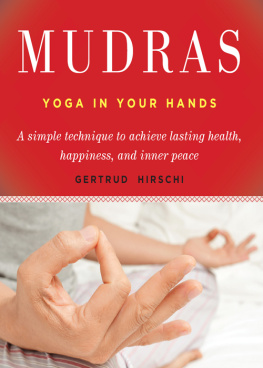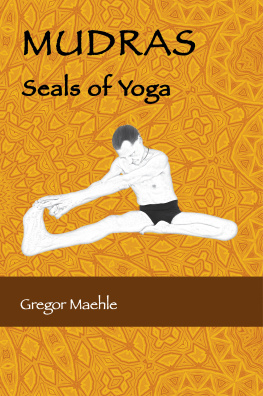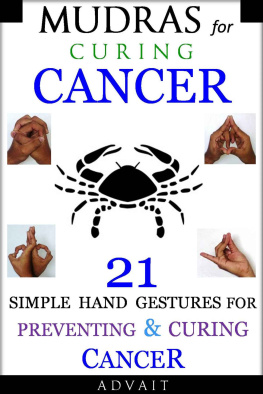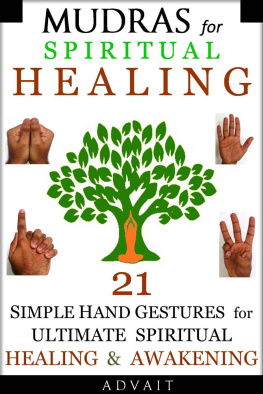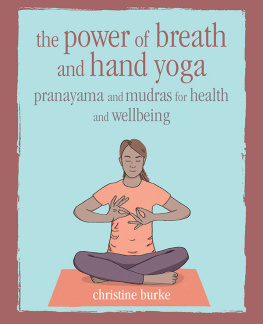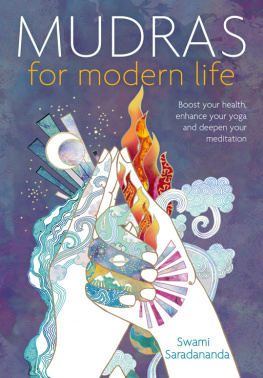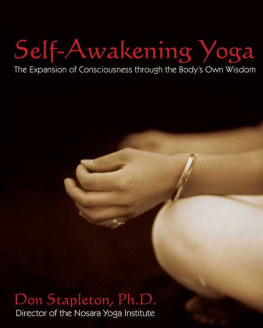
This edition published in 2016 by Weiser Books, an imprint of
Red Wheel/Weiser, LLC
With offices at:
65 Park Street, Suite 7
Newburyport, MA 01950
www.redwheelweiser.com
Copyright 2000 by Gertrud Hirschi
All rights reserved. No part of this publication may be reproduced or transmitted in any form or by any means, electronic or mechanical, including photocopying, recording, or by any information storage or retrieval system, without permission in writing from Red Wheel/Weiser, LLC. Reviewers may quote brief passages. Previously published in 1998 in German as Mudras: Yoga mit dem kleinen Finger, by Herman Bauer Verlag, Freiburg im Breslau, Germany.
ISBN: 978-1-57863-139-1
Library of Congress Cataloging-in-Publication Data
Hirschi, Gertrud.
[Mudras. English]
Mudras : yoga in your hands / Gertrud Hirschi.
p. cm.
Includes bibliographical references and index.
isbn 1-57863-139-4 (pbk : alk. paper)
1. Yoga, Hatha. I. Title.
RA781.7.H57713 2000
613.7046dc21 99-087141
Translated by Christine M. Grimm
Typeset in Jim Warner
Cover photograph Shutterstock nito
Text design by Kathryn Sky-Peck
Illustations by Ito Joyoatmojo
Printed in the United States of America
BP
10 9 8 7 6 5 4 3 2 1
www.redwheelweiser.com/newsletter
CONTENTS

SPECIFIC MUDRAS

Agochari Mudra,
Akashi Mudra,
Apan Mudra,
Apan Vayu Mudra,
Ardha Cakrasana,
Asthma Mudra,
Atmanjali Mudra,
Back Mudra,
Bhramara Mudra,
Bhuchari Mudra,
Bhudi Mudra,
Bhujangani Mudra,
Bhumisparsha Mudra,
Bronchial Mudra,
Detoxification Mudra,
Dharmachakra Mudra,
Dhyani Mudra,
Dynamic Mudra,
Ganesha Mudras,
Garuda Mudra,
Hakini Mudra,
Jnana Mudra and Chin Mudra,
Joint Mudra,
Kaki Mudra,
Kalesvara Mudra,
Kartari Mudra,
Ksepana Mudra,
Kubera Mudra,
Kundalini Mudra,
Limber-Up and Warm-Up Exercises,
Linga Mudra,
Lotus Mudra,
Maha Bandha,
Maha Sacral Mudra,
Mahasirs Mudra,
Makara Mudra,
Matangi Mudra,
Message of Shiva,
Mudra of the Inner Self,
Mukula Mudra,
Mushti Mudra,
Naga Mudra,
Pascimottanasana,
Pashini Mudra,
Pran Mudra,
Prithivi Mudra,
Pushan Mudra,
Pushpaputa Mudra,
Rudra Mudra,
Shakti Mudra,
Shambavi Mudra,
Shankh Mudra,
Shanti Mudra,
Shivalinga,
Shunya Mudra,
Side Stretch,
Suchi Mudra,
Surabhi Mudra,
Tadagi Mudra,
Tse Mudra,
Twist in the Seated Meditation Posture,
Ushas Mudra,
Uttarabodhi Mudra,
Vajra Mudra,
Vajrapradama Mudra,
Varada Mudra,
Varuna Mudra,
Vayu Mudra,
Viparita Karani Mudra,
Yoga Mudra,
Yoni Mudra,
ACKNOWLEDGMENTS

A person can never really complete a work like this alone. In order to write this book, I relied on the contributions of many other people. Many people helped me in the process of gaining knowledge and perception about mudras in general; and many others helped me with my research on the effects of working with mudras. There are many people I would like to thank for their help in this. Within a few months of beginning this project I coincidentally met people who were involved with the mudras either on a scientific and / or practical basis. They had been successfully using mudras for years and generously offered their knowledge for my use. In addition, some of my yoga students tested the mudras and confirmed the findings. From the bottom of my heart, I would like to thank those who helped me.
I sincerely thank Kim da Silva for permitting me to use some of his mudras, which have also helped me personally. Moreover, I would like to thank him for his suggestions and additions. Thanks as well to Elisabeth Steudler for her tips on herbs. Her knowledge, enthusiasm, and love of plants made my heart feel warm and wide.
I thank Ito Joyoatmojo, who drew more than 100 hands. The pictures of the hands on pages 38 and 39 are from G. Hrlimann's Handlesen (Wettsbilt). Many thanks also to Erika Schuler-Konietzny, for her help with my original manuscript.
DEAR READER

W ith this book, I would like to give you and your loved ones (even people who are currently confined to their beds) a practical aid in healing both minor and major complaints. Mudras: Yoga in Your Hands is my fourth book, and four is the number for rest, stability, and order. This is why I originally wanted to bring a book about rest and meditation into our loud world. In Basic Yoga for Everybody, my third book (and the first translated into English), I presented a few mudras (the special finger or hand positions) for intensifying meditation; and then my German publisher requested that I write a book solely on the topic of mudras. This suggestion suited me quite well, since the very nature of mudras is repose, silence, and peace.
I will even dare to claim that most health disorders, whether on the physical or the mental-emotional level, develop from a lack of inner and outer repose and / or too much stress or worry. Since I personally am all too well acquainted with both outer and inner unrest (and have developed some strategies against it with the help of the mudras) I can consider myself healthy and happy today, in both the physical and the mental-emotional sense. I especially enjoy using the mudras since the effort involved is very minimal. We can practice mudras anywhere, anytime, no matter where we are.
Despite the stress that often rules our lives, we are forced to experience periods of rest from time to time. These rest times are also waiting periods. What happens to your mood when you are sitting in traffic, standing in line at the counter, missing the train, twiddling your thumbs at the computer, laying in bed with the flu or a broken bone, or after preparing a meal and your loved ones aren't home? These can all be times of aggravation, inner conflict, or frustration. (I used to hate waiting for anything.) Or they can become times of regeneration and self-communion.
Today, I find that waiting times forced upon me in a quite incidental way, either by the outside world or from inside myself, have become very precious. They are times of pausing. I can use them to gain fresh insight, create new perspectives, or formulate new principles. In yoga, the inner occurrences and their effects are compared with a lake. In everyday life, thoughts and feelings are always in motion, and these movements can be compared with the waves of a lake. The air (mind) moves the water (soul). If a wind springs up, then waves form. If we look into agitated water, then everything is unclear. Our own face and the surrounding world are distorted and clouds (restless and worried thoughts) cover the sun (symbol of the Divine). If the lake is calm, then we can see down to the bottom. Everything reflected in it is clear and beautiful, and we can once again recognize the sun.
By using the mudras in combination with breathing exercises, visualization, and affirmation, I have had wonderful experiences of attaining inner peace and quiet and making the most of the present moment. This is why most of this book consists of these combinations.
Next page
